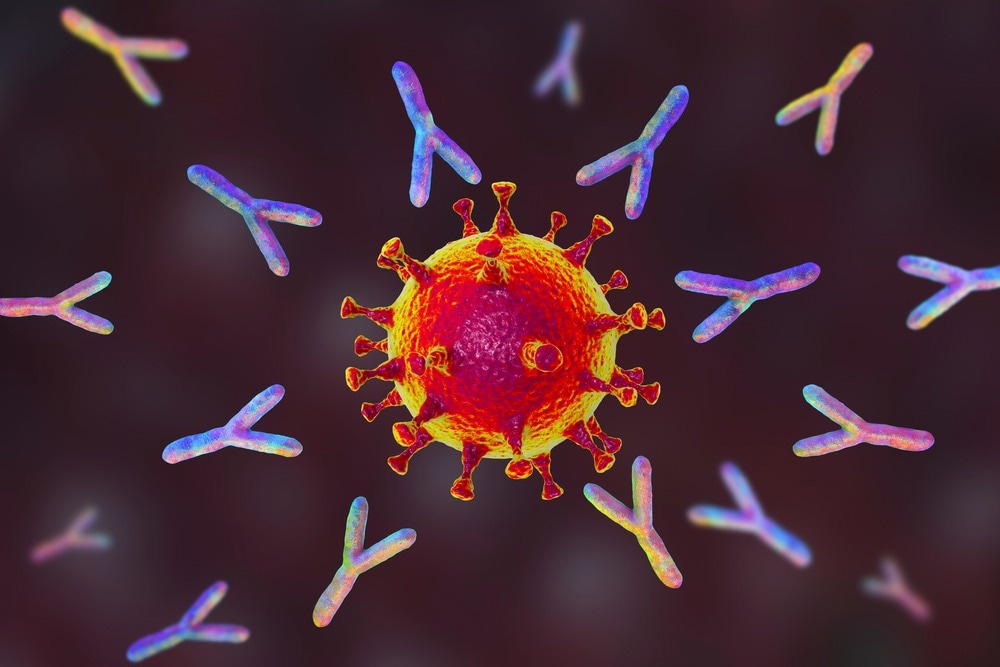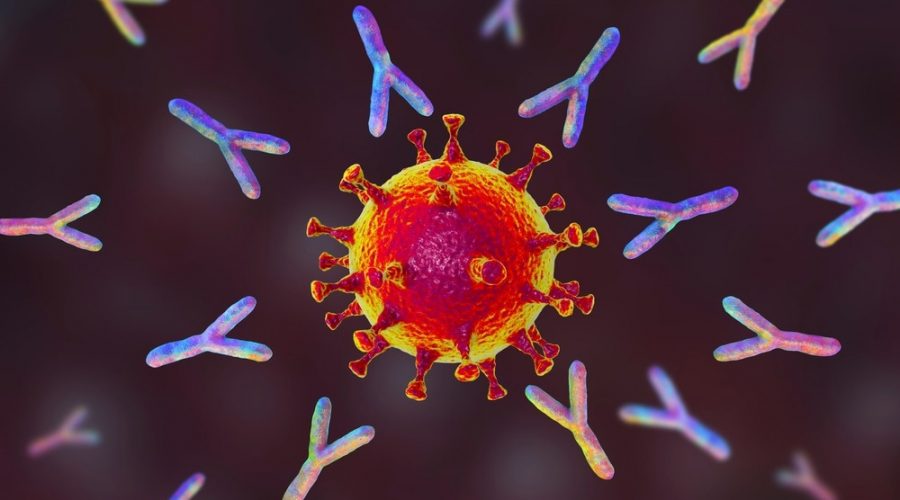A broad sarbecovirus-neutralizing antibody cocktail
In a recent study published on the bioRxiv* preprint server, researchers in China present a rational approach for identifying severe acute respiratory syndrome coronavirus 2 (SARS-CoV-2) spike (S) protein receptor-binding domain (RBD)-targeted broad neutralizing antibody (NAb) cocktails.

Study: Rational identification of potent and broad sarbecovirus-neutralizing antibody cocktails from SARS convalescents. Image Credit: Kateryna Kon / Shutterstock.com
Background
The continual emergence of immune-evasive SARS-CoV-2 variants, such as Omicron variant of concern (VOC) and its sublineages, warrants the need for more potent and broader sarbecovirus SARS-CoV-2 NAb (bsNAb) neutralization with epitopes on the conserved sites of sarbecoviruses.
Several bsNAbs targeting SARS-CoV-2 S subunit 2 (S2) have demonstrated broad SARS-CoV-2 neutralization; however, their potency has been low. Contrastingly, bsNAbs targeting the SARS-CoV-2 RBD have exhibited high potency; however, most of these antibodies have escaped neutralization by Omicron BA.2 and/or Omicron BA.4/BA.5.
About the study
In the present study, researchers propose a rational strategy to discover broad Nabs that are strongly resistant to SARS-CoV-2 RBD mutations.
Fluorescence-activated cell sorting (FACS) analysis, high-throughput deep mutational scanning (DMS), and droplet-based single-cell scV(D)J-sequencing (scVDJ-seq) analyses were performed to isolate cross-reactive memory B lymphocytes from SARS-CoV-2-vaccinated convalescents and screen for the escaping mutations profiles of 314 nAbs.
Epitope clustering analysis was performed to identify the antibody epitopes. In vitro escape mutation screening using SARS-CoV-2BA.1-S-pseudotyped replication-competent recombinant vesicular stomatitis virus (rVSV) and Vero cells was also performed.
Next-generation sequencing (NGS) analysis was used to identify mutations, whereas the international ImMunoGeneTics (IMGT) and global initiative on sharing all influenza details (GISAID) databases were referred for the analysis. Three-dimensional reconstructed structures of BD55-3546/Delta S6P, BD55-4637/BA.1 S6P, and BD55-5514+ BD55-5840 (SA55+SA58)/BA.1 S6P complexes were generated through the use of cryo-electron microscopy (EM).
Structural models of bsNAbs were prepared to visualize multiple sequence alignment (MSA)-aligned structures of S309, S2H97, S304, BD55-1239, ADG-2 in E1, E3, F1, F2, and F3 epitope groups. Human angiotensin-converting enzyme 2 (hACE2)-transgenic mice were challenged by SARS-CoV-2 BA.1 before or after intraperitoneal (IP) and intramuscular (IM) SA55+SA58 treatment to evaluate the anti-SARS-CoV-2 efficacy of SA55+SA58 in vivo.
Murine bodyweight changes were assessed, in addition to their lung and trachea samples that were subjected to quantitative reverse-transcription-polymerase chain reaction (qRT-PCR) analysis to determine viral loads.
Study findings
Approximately 13,000 cluster of differentiation (CD)19+CD27+ immunoglobulin M (IgM)- memory B lymphocytes with cross-binding to SARS-CoV-1 and SARS-CoV-2 RBDs were obtained from 28 convalescents who were administered two CoronaVac vaccine doses and one ZF2001 booster dose in 2021. By scVDJ-seq analysis, 2,838 paired Ab sequences were retrieved from the memory B lymphocytes, of which 1,413 sequences comprising the constant region of IgG1 heavy chain were chosen for the in vitro experiments.
In the epitope clustering analysis, 286 bsNAbs of F1, F3, E1, E3, and F2 epitopes and with sarbecovirus neutralization titers were observed. However, only 12 bsNAbs with non-competing E1, E3, and F3 epitope Abs were further analyzed, of which F1 and E3 bsAbs showed low neutralization and were not considered for developing NAb drugs. The NAbs of the E1 and F2 groups showed high and moderate neutralization potency, respectively.
Group E1 Abs were bound to clade 1a/1b sarbecoviruses. F3 (ADG-2 Ab) NAbs showed binding to sarbecovirus clades that utilize ACE2.
BD55-5840 showed the most potent neutralization of the SARS-CoV-2 ancestral strain and Omicron BA.1 with 90% inhibition concentrations (IC90) values of 5.6 ng/mL and 24 ng/mL, respectively. Conversely, BD55-5514 showed potent BA.1 neutralization with IC90 of 23 ng/mL. SARS-CoV-2 neutralization by F2 group NAbs was less than F3 and E1 Abs.
SA55 was bound in the up RBD configuration only, whereas SA58 was bound in up and down RBD configurations. E1 group Abs formed non-overlapping NAb cocktails with the F2/F3 groups; thus, E1+F3 and E1+F2 Ab cocktails were further analyzed.
E1 and F3 NAbs were centered on the N343 glycan and SARS-CoV-2 S-ACE2 binding site, respectively. BD55-3546 was escaped by T345 and N440 mutations, whereas BD55-5585 and BD55-5549 were escaped by R346, T345, and L441 mutations.
BD55-3546 showed five to 10-fold lower activity against the S371F-containing Omicron variants. BD55-5549 but not BD55-5840 could be escaped by L441 mutations, whereas BD55-5840 was slightly affected by S371F.
Further, BD55-5840 exhibited high potency and less sensitivity to R346 mutations and glycan displacement. Thus, BD55-5840 was the selected E1 group bsNAb.
BD55-3372, BD55-5483, and BD55-5514 were sensitive to V503 and G504 mutations, whereas BD55-4637 was sensitive to N439T/S and Y508 mutations. BD55-5514 was selected as the final F3 bsNAb due to its highest neutralization potency.
BD55-5840 and BD55-5514 showed synergism such that BD55-5840 could engage the up and down RBDs, whereas BD55-5514 blocked ACE2. The SA55+SA58 cocktail exhibited robust anti-SARS-CoV-2 efficacy in vivo and was chosen as the final non-competing bsNAb cocktail.
Conclusions
The study findings demonstrate that the non-competing SA55+SA58 antibody cocktail exhibteid broad sarbecovirus neutralization and high potency against all Omicron sublineages of BA.1, BA.2, BA.2.12.1 and BA.4/BA.5, thus making it a valuable prophylactic and therapeutic drug candidate against sarbecoviruses. Future drug candidates should be targeted at rare and conserved RBD epitopes associated with essential SARS-CoV-2 functions such as ACE2-binding and/or glycosylation.
*Important notice
bioRxiv publishes preliminary scientific reports that are not peer-reviewed and, therefore, should not be regarded as conclusive, guide clinical practice/health-related behavior, or treated as established information.
- Cao, Y., Jian, F., Zhang, Z., et al. (2022). Rational identification of potent and broad sarbecovirus-neutralizing antibody cocktails from SARS convalescents. bioRxiv. doi:10.1101/2022.08.03.499114. https://www.biorxiv.org/content/10.1101/2022.08.03.499114v1.
Posted in: Drug Discovery & Pharmaceuticals | Medical Science News | Medical Research News | Disease/Infection News | Pharmaceutical News
Tags: ACE2, Angiotensin, Angiotensin-Converting Enzyme 2, Antibodies, Antibody, Cell, Cell Sorting, Coronavirus, Coronavirus Disease COVID-19, Drugs, Efficacy, Electron, Electron Microscopy, Enzyme, Fluorescence, Glycan, Glycosylation, Immunoglobulin, in vitro, in vivo, Influenza, Microscopy, Mutation, Omicron, Polymerase, Polymerase Chain Reaction, Protein, Receptor, Respiratory, SARS, SARS-CoV-2, Severe Acute Respiratory, Severe Acute Respiratory Syndrome, Stomatitis, Syndrome, Transcription, Transgenic, Vaccine, Virus

Written by
Pooja Toshniwal Paharia
Dr. based clinical-radiological diagnosis and management of oral lesions and conditions and associated maxillofacial disorders.
Source: Read Full Article
